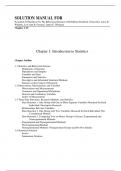Examen
Solution Manual for Essentials Of Statistics For The Behavioral Sciences 10th Edition Frederick J Gravetter, Larry B. Wallnau, Lori Ann B. Forzano, James E. Wi
- Cours
- Établissement
- Book
Solution Manual for Essentials Of Statistics For The Behavioral Sciences 10th Edition Frederick J Gravetter, Larry B. Wallnau, Lori Ann B. Forzano, James E. Wi
[Montrer plus]




